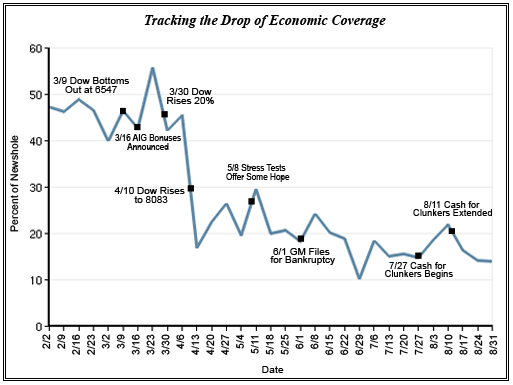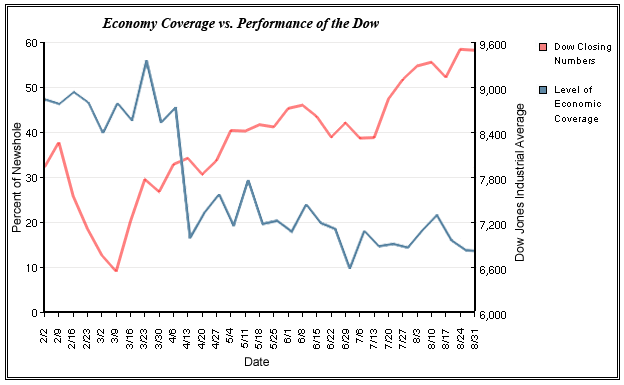>
Fascinating look via a study by Pew Research Center’s Project for Excellence in Journalism, on how well the Media did in covering the financial collapse.
Among the key findings:
• Three storylines have dominated: efforts to help revive the banking sector, the battle over the stimulus package and the struggles of the U.S. auto industry. Together they accounted for nearly 40% of the economic coverage from February 1 through August 31. Other topics related to the crisis have been covered much less. As an example, all the reporting of retail sales, food prices, the impact of the crisis on Social Security and Medicare, its effect on education and the implications for health care combined accounted for just over 2% of all the economic coverage.
• Actions by government officials and business leaders drove much of the coverage. The White House and federal agencies alone initiated nearly a third (32%) of economic stories studied through July 3. Business triggered another 21%. About a quarter of the stories (23%) was initiated by the press itself and did not rely on an external news trigger. Ordinary citizens and union workers combined to act as the catalyst for only 2% of the stories about the economy.
• Fully 76% of the datelines on economic stories studied during the first five months of the Obama presidency were New York (44%) or metro Washington D.C. (32%). Only about one-fifth (21%) of the stories originated in any other city in the U.S., and about a quarter of those emanated from two other major media centers: Atlanta and Los Angeles.
• When it came to which phrases and ideas reverberated most in a broad array of media, an analysis of some 1.6 million news websites, blogs and other online sources finds that the president dominated. Nine of the top 20 most-quoted phrases came from him. But among Republicans, it was 38-year-old Louisiana Governor Bobby Jindal’s voice that carried the furthest—not any of the national party leaders. Overall, Republicans accounted for just four of the top 20 “memes” tracked in the analysis.
• Once the economic situation showed some signs of improvement—and the political fights over legislative action subsided—media coverage began to diminish. After accounting for 46% of the overall news coverage in February and March, for instance, coverage of the economic crisis dropped by more than half (to 21% of the newshole studied) from April through June. And in July and August, it fell even further (to 16%). The clearest example came in cable news. Once the political battles subsided, coverage fell by about two-thirds from March to April.
In general, the stories that got heavier coverage were those that involved institutions, happened in New York or Washington, and involved deep-seated ideological passions. Consider the top three:
• Coverage of the banking industry was driven by Treasury Secretary Timothy Geithner’s apportioning the remaining TARP funds (the program was started during the Bush Administration) in February, the announcement of the Public-Private Investment Program in March, the results of bank “stress tests” in May and moves by some TARP recipients to pay back the government loans.
• Attention to the stimulus package came mainly during the heated debate in Congress over its passage. In February alone, stimulus reporting commanded 36% of the economic newshole, reflecting the magnitude of the $787 billion program and also the partisan battle that culminated with 60 votes in the U.S. Senate. (There was another smaller spike, 14%, in July when questions about the impact of the stimulus and talk about a possible second stimulus drove that narrative.)
• Coverage of the auto business often involved the supercharged issue of whether the government should be involved in taking over a troubled industry and the question of whether it could let American automakers fail. Yet the storyline devoted specifically to labor issues and worker layoffs in the car industry barely registered in the coverage.
>
>
Source:
Covering the Great Recession
October 5, 2009
http://www.journalism.org/analysis_report/covering_great_recession




What's been said:
Discussions found on the web: